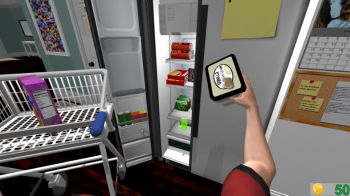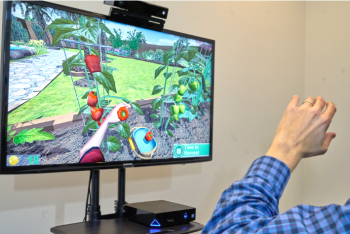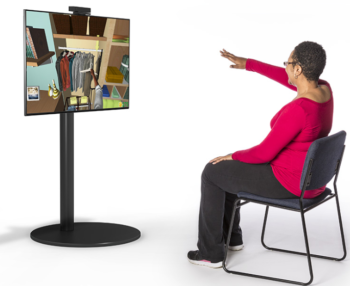SaeboVR
SaeboVR is an FDA-cleared and CE Marked software system, used with the Microsoft Kinect, intended to be used to support repetitive task practice for rehabilitation of adults in a clinical or home setting consistent with Standard of Care for upper extremity (UE) rehabilitation. The system is based on simulated activities of daily living (ADLs) for the UE within a virtual world. SaeboVR uses a Microsoft Kinect Sensor to track patient shoulder and elbow movements, which are translated into equivalent movements of a graphical avatar that represents the patient in a virtual environment.
An NIH-funded clinical study was conducted by the University of Virginia (UVa) and UVa HealthSouth from February 2016 to February 2017 to assess the efficacy of the system for use in UE rehabilitation. The study, titled Virtual Occupational Therapy Application (VOTA), was performed under an NICHD Phase II SBIR grant (2R44HD071745-02) to Barron Associates, Inc. Primary investigational hypothesis was that practice of virtual ADLs would lead to an improvement in UE motor function in chronic stroke survivors, as measured by an UE sub-scale of the Fugl-Meyer assessment (FMEU) and the Wolf Motor Function Test (WMFT). A total of 15 stroke patients meeting study inclusion and exclusion criteria completed 8 weeks of virtual ADL therapy.
Analysis of study results confirmed the primary investigational hypothesis. Mean improvement in the FMUE score (6.1; 95% CI: [3.8, 8.4], p<0.001) was both significant and clinically important. WFMT results likewise showed significant improvement in UE motor function. SaeboVR has thus been shown to be efficacious for improving UE motor status in stroke patients.

Saebo, Inc. is currently offering 10-day free trials of the SaeboVR system for qualified institutions. For more information, contact Saebo, Inc. (www.saebo.com, 888.284.5433).
SaeboVR is Evidence-Based!
Adams, R.J., Lichter, M.D., Krepkovich, E.T., Ellington, A., White, M., and Diamond, P.T. (2015). Assessing Upper Extremity Motor Function in Practice of Virtual Activities of Daily Living. IEEE Transactions on Neural Systems and Rehabilitation Engineering, 23:2.
Ellington, A., Adams, R., White, M., & Diamond, P. (2015). Behavioral intention to use a virtual instrumental activities of daily living system among people with stroke. American Journal of Occupational Therapy, 69, 1-8.
Equipment Update:
In response to Microsoft’s decision to discontinue manufacturing of the Kinect (announced on October 25, 2017), Barron Associates has identified an equivalent sensor solution from an alternate vendor. This new solution provides an equivalent tracking capability to the Kinect’s. Additionally, to eliminate any short-term impact, the company has secured a sufficient number of Kinect sensors to ensure all needs are met during the transition.
For pricing and ordering information, contact sales@barron-associates.com


